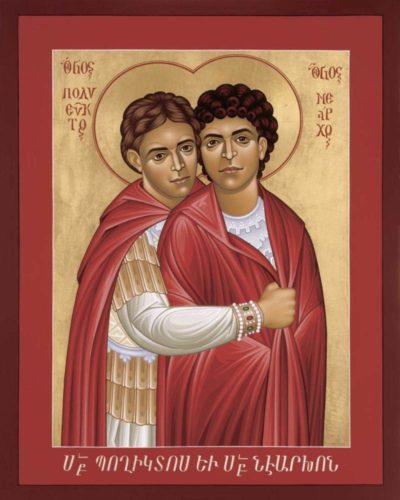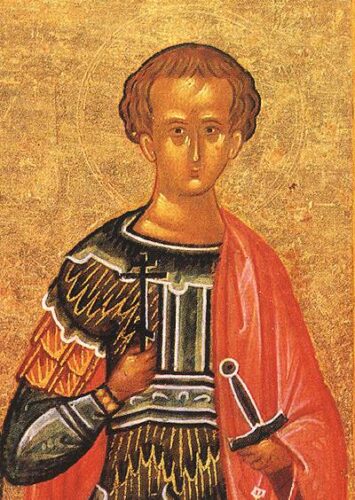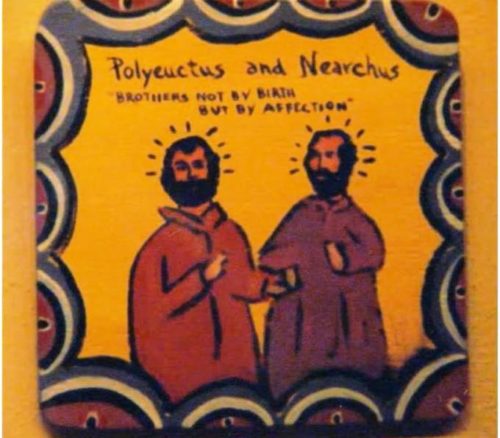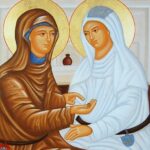Last Updated on October 6, 2024 by Kittredge Cherry

Saints Polyeuct and Nearchus were Roman soldiers in 3rd-century Armenia and “brothers by affection.” They are a prime example of same-sex lovers in the early church. Polyeuct’s feast day is Feb. 13.
The earliest account of Polyeuct’s martyrdom, a 4th-century Armenian biography, says that they were “brothers, not by birth, but by affection” and enjoyed “the closest possible relationship, being both comrades and fellow soldiers.”
Polyeuct and Nearchus look almost like a gay Valentine as they embrace in an icon by Brother Robert Lentz, a Franciscan friar and world-class iconographer known for his innovative icons. Prints of “Saints Polyeuct and Nearchus” by Robert Lentz are available through Amazon and Trinity Stores. It is one of 10 Lentz icons that have sparked controversy since in 2005 when conservative Roman Catholic leaders accused Lentz of glorifying sin and creating propaganda for a progressive sociopolitical agenda.
Both saints have many variations on their names, including Polyeuctus or Polyeuctes and Nearch or Nearchos.

St. Polyeuctus (Wikimedia Commons)
Nearchus was Christian, but Polyeuct was not. They probably spoke their local language and Latin, the official language of the Roman military. The men had a strong desire to spend eternity together, so Polyeuct converted from paganism to Christianity, the faith of his beloved Nearchus. With a convert’s zeal he attacked a pagan procession. He was beheaded for his crime in the year 259 in the western Armenian city of Militene. Shortly before he was executed, he spoke his last words to Nearchus: “Remember our secret vow.” Thus Polyeuct is known as a protector of vows and avenger of broken promises, in addition to his role as a probable “gay saint.”
Yale history professor John Boswell names Polyeuct and Nearchus as one of the three primary pairs of same-sex lovers in the early church. (The others are Perpetua and Felicity and Sergius and Bacchus.) The love story of Polyeuct and Nearchus is told with extensive historical detail in two books, “Same Sex Unions in Pre-Modern Europe” by Boswell and “Passionate Holiness
” by Dennis O’Neill. He is founder of the Living Circle, the interfaith LGBT spirituality center that commissioned the above icon of the loving same-sex pair.
Artists portray Polyeuct and Nearchus
Artist Jim Ru was also inspired to paint Polyeuct and Nearchus. His version was displayed in his show “Transcendent Faith: Gay, Lesbian and Transgendered Saints” in Bisbee Arizona in the 1990s.

Polyeuctus and Nearchus by Jim Ru
Finnish artist Kalle Hamm created an image of Polyeuct and Nearchus that is suitable for society now, when “icon” is more likely to mean a computer symbol than a religious figure. He writes their story using emoji with the goal of affirming LGBTQ people in a contemporary, accessible way. Hamm’s 2018 “New Icons” series includes these and many other same-sex pairs of saints who suffered for their beliefs.

“New icon: Saints Nearchus and Polyeuctus” by Kalle Hamm
O’Neill reports that French writer Robert Dartois recently took the story of Polyeuct and Nearchus from “Passionate Holiness” and turned it into a libretto, which was then set by the Swiss composer Thierry Chatelain as the oratorio “Polyeucte et Nearchus.”
There are many variations in the spellings of their names, such as Polyeuctus, Polyeuctes, Polyeuktos and Nearchos and Nearch. Polyeuct’s feast day is Feb.13 in the Catholic calendar, but falls on Jan. 9 in the Eastern Orthodox tradition and Jan. 7 in ancient Armenian calendars. The feast day for Nearchus is April 22.
___
Related links:
Saints Polyeuct and Nearchos, 3rd Century Lovers and Martyrs (Queer Saints and Martyrs — And Others)
Orthodox Prayer for Polyeuctus the Martyr of Melitene in Armenia (goarch.org)
Hermanos de afecto: Santos Polieucto y Nearco (Santos Queer)
___
Top image credit: “Saints Polyeuctus and Nearchus” by Robert Lentz. Prints of “Saints Polyeuct and Nearchus” by Robert Lentz are available through Amazon and Trinity Stores.
___
This post is part of the LGBTQ Saints series by Kittredge Cherry. Traditional and alternative saints, people in the Bible, LGBTQ martyrs, authors, theologians, religious leaders, artists, deities and other figures of special interest to lesbian, gay, bisexual and transgender and queer (LGBTQ) people and our allies are covered.
The first version of this article was posted in February 2010 on the Jesus in Love blog and updated regularly with new material. It was published on Q Spirit in February 2017, was expanded with new material over time, and was most recently updated on Oct. 6, 2024.
Copyright © Kittredge Cherry. All rights reserved.
Qspirit.net presents the Jesus in Love Blog on LGBTQ spirituality.




















This article itself admits that the only slim basis for calling them “lovers” is the fact that one source describes them as “brothers, not by birth, but by affection… being both comrades and fellow soldiers.” Numerous soldiers in all eras have considered themselves “brothers” and have a close bond, which does not have anything to do with romance. Talk to any U.S. soldier today. And once again you’re using John Boswell’s ideas which were debunked even by gay historians such as Alan Bray. Boswell has zero credibility with historians, and if you want to maintain any credibility you need to stop repeating his nonsense.
I have search you tube for the libretto by Thierry Chalelain not found. Any ideas where we can listen to this work?
I have also searched for Thierry Chatelain’s libretto without finding it. You could try contacting him directly through his website:
https://www.thierrychatelain.com/
Please let me know if you find it, and I will post the link here!
Do we have a prayer or collect for this feast day?
After a lot of searching, I did find a prayer for St. Polyeuct at this link — with a strict warning not to copy the prayer: http://www.goarch.org/chapel/saints_view?contentid=378&type=saints
I like the part about how Polyeuct “cast down the tyrants,” but it would be great if somebody wrote an updated prayer suitable for sharing here on the Jesus in Love Blog.
Thanks for raising an important question. I added the link to my main article.